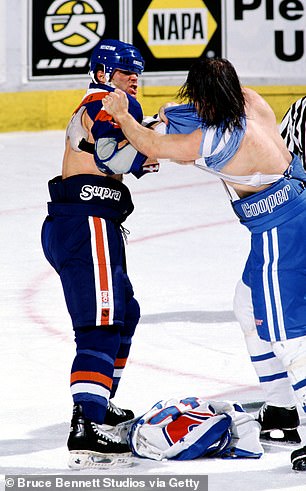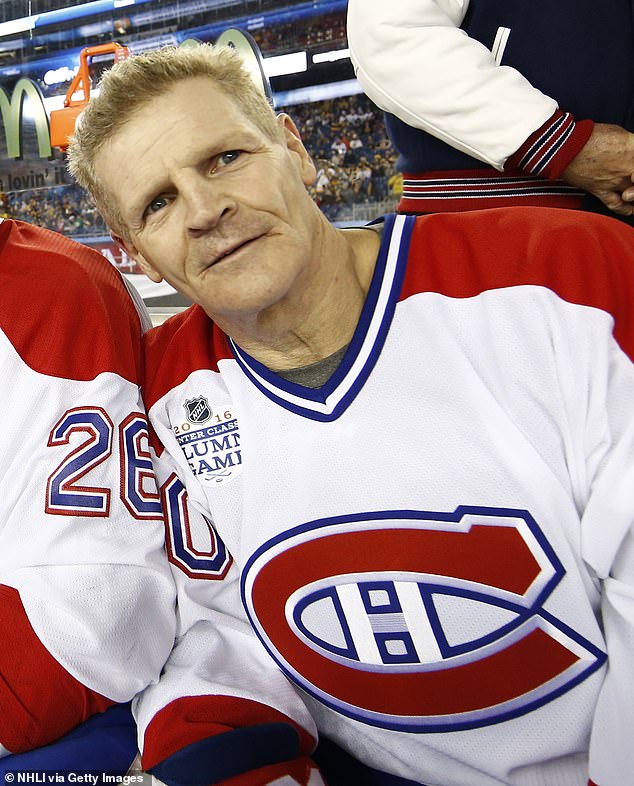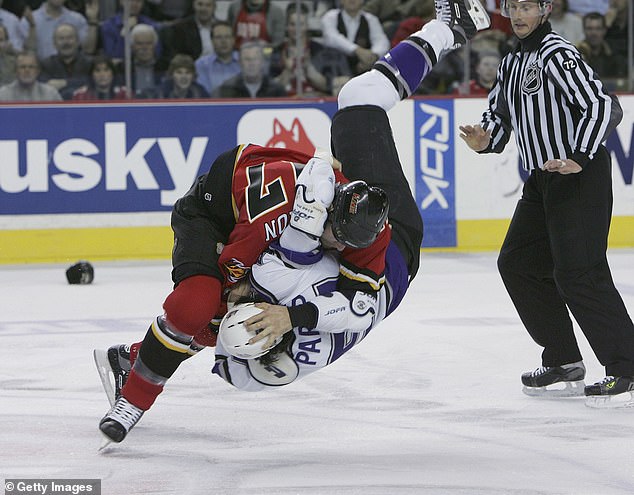As critics blame Chris Simon’s suicide on head injuries and NHL brawls, former Canadiens enforcer Chris ‘Knuckles’ Nilan says it’s far more complicated: ‘We can’t draw a straight line from fighting to CTE’
The age-old debates about violence and head injuries in hockey were reignited this week by the tragic suicide of former NHL enforcer Chris Simon, a complicated 52-year-old former player who was refereed for 101 fighting majors in his 15-year life. career.
“I am angry and devastated by such a senseless tragedy,” NHL agent Allan Walsh wrote on X. “101 fighting majors and (NHL commissioner) Gary Bettman still denies the cumulative effects of repeated head impacts. There’s blood on Gary’s hands. My condolences and condolences to Chris’ family and friends.’
The degenerative brain disease chronic traumatic encephalopathy (CTE) has already been blamed for Simon’s death by his family, who explained in a statement that he had “struggled immensely” with the condition. But CTE can only be diagnosed posthumously, so the final conclusion, as well as other potential factors, may not be verified for some time.
Complicating the discussion further is the source of Simon’s potential CTE. While Deputy Commissioner Bill Daly on Wednesday denied the link between repetitive head trauma and the brain disease, angry fans have insisted Simon’s death was the direct result of brain injuries during his many on-ice brawls.
But for Chris “Knuckles” Nilan, a 66-year-old former Montreal Canadiens enforcer, fighting isn’t the only possible culprit. Speaking to DailyMail.com in the aftermath of Simon’s death, Nilan questioned the conclusion that fighting inherently leads to CTE, instead suggesting that violent controls are primarily responsible for head trauma in hockey.

Chris Simon (far left, near right) developed a reputation as one of the NHL’s toughest players

Retired Montreal Canadiens winger Chris ‘Knuckles’ Nilan is pictured at an exhibition in 2016
“When guys get shoulder-to-shoulder body checks and hit the boards, there’s some disturbance in the mind, right?” Nilan, a native of South Boston, told DailyMail.com from his adopted home of Montreal. ‘The brain moves in that skull. So it’s not just a blow, it’s a lot more than a blow.
“I’m not saying this can’t happen in fights, and it has,” Nilan continued. “But I believe that the cases where guys get major concussions come more from violent body checks than from (bumps) to the head.”
Nilan carefully refrained from making assumptions about Simon’s condition: “I don’t know if he had (CTE) or not.”
There is some anecdotal evidence that Simon had the disease: his two divorces, a bankruptcy in 2017, and doctor-diagnosed depression, anxiety, and post-traumatic stress disorder are all hallmarks of someone struggling with CTE.
But for Nilan and the many researchers who study CTE, deciphering correlation from causation can be difficult.
“I think it’s really hard for me because I always see people wanting to draw a straight line from hockey fighters to CTE and that’s why they got it: ‘because they were fighting,’” Nilan said.

Chris Simon turns over George Parros of the LA Kings during a brawl in Calgary in 2006
Nilan cannot speak knowledgeably about Simon’s decline, because he did not know him very well. His own career ended in 1992, just as Simon entered the league as a burly 6-foot-1 winger with long hair and a scruffy disposition.
The two met at a gym in California in the early 2000s (“He was a really nice guy”), but while Nilan wasn’t close to Simon personally, he knows what it’s like to wrestle as a retiree from the NHL. Only in his case it involved addiction to alcohol and prescription drugs.
As for CTE, Nilan doesn’t know if he has the disease and it’s not something he worries much about. He has performed well on recent cognitive exams despite decades of abuse on and off the ice, and although his own mother battled dementia, the retired winger believes he has avoided any noticeable decline.
But after about 300 NHL fights, Nilan shares some traits with deceased former athletes who battled the brain disease. For example, in addition to his addiction to painkillers and booze, there were his well-known problems with anger management.
So like many of his retired NFL counterparts, Nilan has agreed to donate his brain to Boston University’s CTE Center so he can posthumously aid researchers’ efforts to solve this problem.
Nowadays Nilan is the host of his own podcast, Raw knuckleswhere he interviews many former and current NHL figures on a variety of topics, including the safety of the sport.
And while it may come as a surprise to some who want to see fighting eradicated from the NHL, Nilan believes it still serves a purpose.
“I know sometimes it can be a deterrent, and I don’t say that all the time, but it can be a deterrent,” Nilan said.
For him, fighting offers a way to police a sport that officials find difficult to regulate.
“I saw a guy get two hands on the head in Boston this year and nothing,” Nilan said. “It wasn’t even a penalty.”
Fighting, he explained, gives players the opportunity to call each other out for dirty play in a way that referees cannot.
“If you open the door to arguing, I think you’ll see a lot of cases where people do crazy things,” he continued. “Like if it’s a chicken wing elbow to someone’s head and knocks them out cold, or leaves their feet up and rams their head through the glass or someone runs through the boards from behind and then they don’t get up and lie there.”
Nilan doesn’t think all fights are justified, and he’s encouraged to see fewer and fewer enforcers have graced NHL rosters in recent years. While decades ago teams had one or two players who could do little other than fight, today even the league’s greatest fighters are skilled.
“I think they’ve made great progress in stopping all that stuff and stuff,” he said. ‘And stopping the man who just sits on the bench and starts fighting is also not an issue.’
When asked if the NHL is doing enough to help former players, Nilan pointed to his two stints in rehab, both of which were paid for by the league: “They were there for me.”
But when it comes to the current players, Nilan believes more can be done.
Most importantly, Nilan said, the league could bring back the red line at center ice, reinstating the NHL’s abandoned rule against crossing two lines. The rule existed from 1943 to 2005 and was intended to prevent teams from firing passes from their own defensive zone to a player who was the icing on the cake on the other half of the ice.
But the rule against double-line passing also slowed down the game, reducing the number of high-impact checks.
“It’s a little different when that red line is there and teams have to go on the ice together,” Nilan said. “They just can’t suddenly turn behind their net, skate as fast as they can, cut across the ice past the red line, send the puck in where a defenseman has to run back and get it and you’ve got someone above you going 90 miles per hour.”
The problem, Nilan said, is that the league likes the faster pace of play: “There are things they could do if they wanted to, but they don’t want to do that.”
The league isn’t ready to finally put an end to the fighting — something that has alternately helped and hindered the sport’s popularity over the years.
Data on the dangers of NHL brawls is still lacking, but a 2023 Columbia University study found that enforcers die an average of 10 years earlier than their fellow players.
Dr. Dave Ellemberg, a professor at the University of Montreal, argued that the study strengthened the case against fighting in the NHL.
But many skeptics, including Nilan, remain. Without fighting, they say, NHL players will become dependent on cheap shots to gain an edge. And in a sport that relies on razor-sharp skate blades and 65-inch fiberglass poles, that could be even more dangerous.
“I will defend it, probably until the day I die,” Nilan said of fighting.
